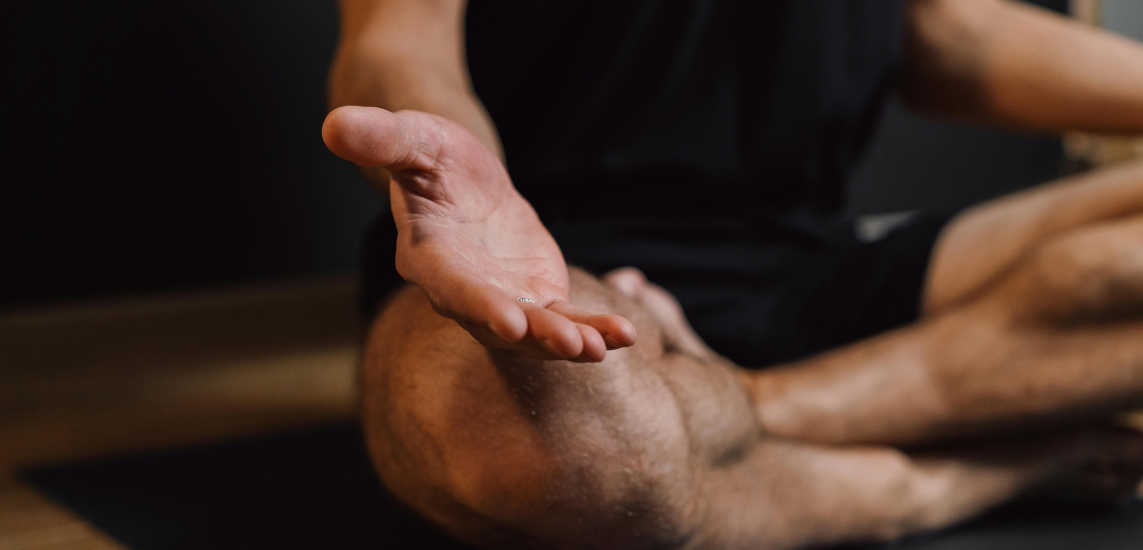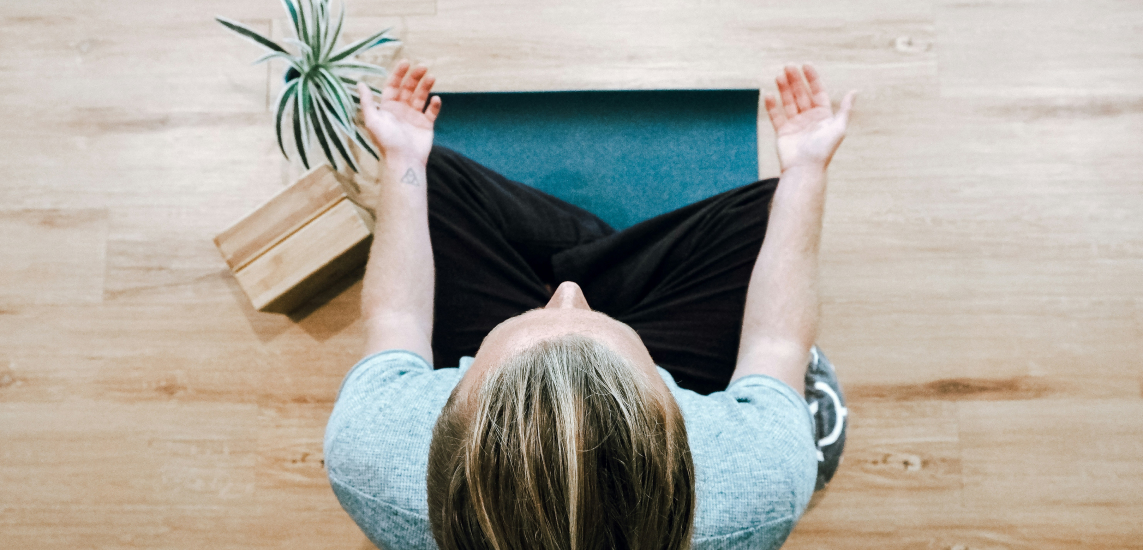From the moment we wake until we drift off to sleep, our eyes are hard at work. With an average screen time of 6 hours and 40 minutes each day, it’s no wonder they grow weary! Our eyes deserve breaks, just like any other muscle in our body.
In this article, we’ll explain the symptoms of tired eyes and guide you through simple techniques to soothe your eyes, including mindful eye exercises and meditation.
Key takeaways:
- Understand the signs of tired eyes and why resting them throughout the day is important.
- Learn the many ways we can rest our eyes, including workspace adjustments, mindful breaks, and meditation.
- Incorporate meditation, like body scans and concentration practices, into your daily routine to support eye health.
Why resting your eyes is important
For most of us, screens and devices dominate our daily activities. But constant exposure to harsh, pixelated screens, coupled with factors like lack of sleep and allergens, can significantly strain our eyes. Research confirms that 90% of digital device users experience symptoms of digital eye strain. This can look like:
- eye pain
- headaches
- blurry vision
- heavy eyelids
- dry eyes
These are all signals that our eyes need a break, just like any other muscle that becomes fatigued over time. With simple eye relaxation techniques and mindful exercises, you can alleviate tension and prioritize your eye health so your eyes can continue to do their job pain-free.
How to rest your eyes
There are many ways to care for our eyes in today’s screen-heavy world, including:
- workspace setup adjustments
- breaks
- mindfulness practices
- eye relaxation exercises
Explore the simple techniques in detail below.
Need some help soothing your eyes? Try this playlist of guided audio meditations for eye relaxation.
Follow the 20:20:20 rule
Many optometrists agree — taking frequent breaks from our screens can significantly reduce eye strain. Their simple rule of thumb is:
For every 20 minutes of screen time, look away for 20 seconds, and let your eyes settle on an object around 20 feet away from you.
A 20-second break may feel short, but studies prove these regular resets are effective, especially for those with computer vision syndrome. By shifting our focus to a distant object, we allow our eye muscles to relax and readjust, reducing fatigue and discomfort.
That said, you don’t have to follow the 20:20:20 rule to a tee — setting a timer every 20 minutes may not be sustainable for everyone. Instead, you can try practicing mindful awareness whenever your eyes begin to strain and then take a short break.
Looking to incorporate a mindfulness practice into your daily routine? Use your short breaks for a mindful check-in anytime throughout the day.
Optimize your workspace
How we set up our workspace can mean the difference between ease and discomfort. To help avoid squinting and other eye problems, here are some ways to adjust your workspace:
- Dim the lighting to minimize glare and harsh contrasts.
- Decrease your computer brightness if you work past sunset.
- Try computer glasses to block the blue light emitted by digital screens.
- Position your screen at eye level, approximately an arm’s length away.
- Invest in ergonomic accessories that help you maintain eye level, whether you sit or stand.
While these may seem like small adjustments, research shows that maintaining an optimal setup can greatly reduce ocular complaints. It’s important to reevaluate your setup if you’re experiencing tension, headaches, or difficulty focusing.
Treat your eyes
For a relaxing remedy, try applying a warm compress to your eyes. The eye area can be sensitive, so ensure your hands and washcloth are clean and the water isn’t hot. Once soaked in lukewarm water, apply the washcloth to your eyes without pressure for a few minutes. This natural treatment can help relieve any soreness, itchiness, or strain.
An alternative is using tea bags as a cold compress. After brewing the tea and allowing the bags to drain and cool completely, you can rest them on your eyelids for soothing relief.
While your eyes are closed, relax even more with a mindfulness meditation. Try one of these meditations for releasing eye tension.
Do mindful eye exercises
Eye exercises help improve visual comfort, reduce eye strain, and maintain optimal eye health. Try a few of the mindful eye techniques below for even more comfort and ease.
Use your palms
Start by rubbing the palms of your hands together quickly to generate warmth, then gently cup them over your closed eyes without applying pressure. Allow the darkness and warmth to envelop your eyes, offering them a moment of rest and rejuvenation. Focus on taking slow, deep breaths while in this position.
Roll your eyes
Roll your eyes gently in a circular motion several times, first clockwise and then counterclockwise. Alternatively, try tracing a horizontal figure-eight with your eyes. Be sure to go slowly and mindfully, maintaining awareness of your surroundings.
This method can help ground you while reducing eye strain by:
- engaging and relaxing the muscles responsible for focusing and movement
- improving blood circulation to the eyes
- relieving tension and fatigue
Actively blink
Blinking is usually something we do subconsciously. However, studies show that long periods of staring at a screen tend to result in less blinking. This can lead to:
- dry eyes
- itchiness
- soreness
- puffiness
Blinking intentionally and mindfully at frequent intervals ensures our eyes stay moisturized, making it easier to stay focused on work throughout the day.
Switch your focus from near to far
Alternating your focus between near and far objects can:
- strengthen eye muscles
- improve depth perception
- reduce eye fatigue
Choose a nearby object and focus on it for a few breaths, then shift your gaze to a distant object and focus on that for another few breaths. Aim for deep, mindful breaths to release tension. Continue alternating between near and far objects, allowing your eyes to adjust and refocus with each change. Engage in this practice at a speed that feels most comfortable for you.
Massage your eye sockets
Like other muscles, a massage can help soothe our eyes when they’re overworked. Eye massages can increase blood circulation and relieve fatigue. Here’s how to perform one:
- Using your fingertips, apply light pressure in small circular motions around your eye sockets.
- Start from the inner corners and work your way outward, but don’t apply pressure directly to the eyeballs.
- Be mindful of your body’s sensations and reactions. You may even want to massage your temples for more relief.
Listen to a guided meditation
Guided meditations provide a soothing break from glaring lights and screens. A 2011 study even found positive improvements in headaches — a common symptom of eye strain and computer vision syndrome — following visualization meditations.
Concentration meditation can also improve strained or tired eyes. In this practice, rest your attention on a single point or object, allowing distracting thoughts and tension to melt away as you immerse yourself in the present moment.
Let yourself be guided into a relaxed state of awareness with one of these concentration meditations.
- Somatic Movement: Restful Eyes Margaret Rinaldi 26:52
- Eye Relaxation Andrew Johnson 3:09
- Mindful Seeing For Being Present Donna Rucinski Harrington 2:15
- Rest Your Eyes & Calm Your Nervous System Dayana 27:59
- Mindfulness of Sight Peter Radcliffe 3:38
- Finding Stillness Beth Budesheim 12:06
- Meditation For Sleep - Mindfulness Of The Eyes The BioMedical Institute of Yoga and Meditation 9:47
- Guided Practice For Healthy Eyes And Greater Vision Stasia Bliss 16:27
Get regular eye checks
While at-home mindfulness exercises can help relieve tension, they don’t replace visiting an eye doctor. Your optometrist can determine whether your eye fatigue is a symptom of something else, like nearsightedness or astigmatism. In those cases, you may need prescription glasses or contact lenses to correct the issue and reduce the strain on your eyes.
Always follow the advice of your eye doctor for personalized eye care tailored to your specific needs and concerns.
Your eyes deserve a break
In today’s digital environment, it’s easy to get lost in our devices without thinking about the impact they have on our eyes. But now that you know how to relax your eyes, you can give them the break they deserve now and then. This is especially important if you notice signs of eye strain.
Take that well-deserved break now: close your eyes and listen to a guided meditation from Insight Timer’s library of over 200,000 free tracks.
FAQs about how to relax the eyes
How often should I be doing eye exercises?
Try to perform short eye exercise sessions several times a day. Remember to take breaks and listen to your body’s signals for what feels right for you. Consistency is the best way to care for your eye health in the long term.
How do I mindfully relax my eye muscles?
There are several ways to relax our eye muscles, including screen breaks, eye compresses, guided meditations, and more. Progressive muscle relaxation, for instance, can be an effective mindfulness practice. Here’s how to do it:
- Begin by finding a comfortable position and closing your eyes.
- Start at the crown of your head and gradually focus your attention on each body part while moving downward.
- When you reach your eyes, consciously release any tension you may be holding.
- Visualize your eye muscles softening and relaxing with each breath.
Learn how to practice body scan meditations with Insight Timer’s extensive library of free guided meditations and courses.
How do you cure computer vision syndrome?
Computer vision syndrome (CVS) refers to a range of eye-related symptoms caused by prolonged use of digital devices like computers, tablets, and smartphones. Symptoms may include:
- eye strain
- dryness
- blurred vision
- headaches
If you’re experiencing any of these symptoms and suspect CVS, consult with an optometrist or ophthalmologist. They can provide professional advice and recommendations to reduce discomfort and prevent further eye strain. Regular eye exams are also essential for maintaining optimal eye health, especially in the digital age.
Disclaimer: This article is for information only and should not be considered as medical advice. If you have concerns about anxiety or any other conditions mentioned in this article, please seek a medical professional for help.
References
Abdoli, S., Rahzani, K., Safaie, M., & Sattari, A. (2011). A randomized control trial: the effect of guided imagery with tape and perceived happy memory on chronic tension-type headache. Scandinavian Journal of Caring Sciences, 26(2), 254–261. https://doi.org/10.1111/j.1471-6712.2011.00926.x
Abusharha, A. (2017). Changes in blink rate and ocular symptoms during different reading tasks. Clinical Optometry, Volume 9, 133–138. https://doi.org/10.2147/opto.s142718
Agarwal, S., Goel, D., & Sharma, A. (2013). Evaluation of the Factors which Contribute to the Ocular Complaints in Computer Users. Journal of clinical and diagnostic research: JCDR, 7(2), 331–335. https://doi.org/10.7860/JCDR/2013/5150.2760
Alghamdi, W., & Alrasheed, S. H. (2020). Impact of an educational intervention using the 20/20/20 rule on Computer Vision Syndrome. African Vision and Eye Health, 79(1). https://doi.org/10.4102/aveh.v79i1.554
Begum, F., Sayed, S. a. M., Almalki, M., Ahmed, R. M., & El-Slamoni, M. a. A. (2022). Time Spent on Digital Screen and its Impact on Health and Academic Performance of Youth. Saudi Journal of Nursing and Health Care, 5(8), 161–166. https://doi.org/10.36348/sjnhc.2022.v05i08.001
Coles-Brennan, C., Sulley, A., & Young, G. (2019). Management of digital eye strain. Clinical & experimental optometry, 102(1), 18–29. https://doi.org/10.1111/cxo.12798
Talens‐Estarelles, C., Cerviño, A., García‐Lázaro, S., Fogelton, A., Sheppard, A. L., & Wolffsohn, J. S. (2023). The effects of breaks on digital eye strain, dry eye and binocular vision: Testing the 20-20-20 rule. Contact Lens & Anterior Eye/Contact Lens and Anterior Eye, 46(2), 101744. https://doi.org/10.1016/j.clae.2022.101744


-1.jpg)




